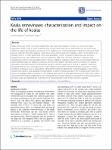Koala retroviruses: characterization and impact on the life of koalas
Denner, Joachim
Young, Paul R.
Koala retroviruses (KoRV) have been isolated from wild and captive koalas in Australia as well as from koala populations held in zoos in other countries. They are members of the genus Gammaretrovirus, are most closely related to gibbon ape leukemia virus (GaLV), feline leukemia virus (FeLV) and porcine endogenous retrovirus (PERV) and are likely the result of a relatively recent trans-species transmission from rodents or bats. The first KoRV to be isolated, KoRV-A, is widely distributed in the koala population in both integrated endogenous and infectious exogenous forms with evidence from museum specimens older than 150 years, indicating a relatively long engagement with the koala population. More recently, additional subtypes of KoRV that are not endogenized have been identified based on sequence differences and host cell receptor specificity (KoRV-B and KoRV-J). A specific association with fatal lymphoma and leukemia has been recently suggested for KoRV-B. In addition, it has been proposed that the high viral loads found in many animals may lead to immunomodulation resulting in a higher incidence of diseases such as chlamydiosis. Although the molecular basis of this immunomodulation is still unclear, purified KoRV particles and a peptide corresponding to a highly conserved domain in the envelope protein have been shown to modulate cytokine expression in vitro, similar to that induced by other gammaretroviruses. While much is still to be learned, KoRV induced lymphoma/leukemia and opportunistic disease arising as a consequence of immunomodulation are likely to play an important role in the stability of koala populations both in the wild and in captivity.
No license information

